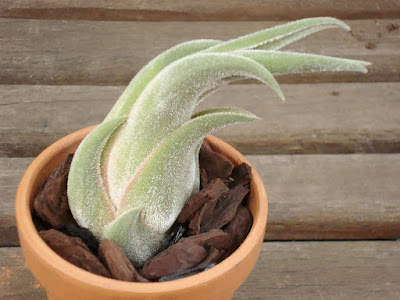Tillandsia seleriana is native to Central America, especially southern Mexico and El Salvador. It is found up to an altitude of 2400 meters above sea level.
Tillandsia seleriana is an air plant species of the genus Tillandsia. This species was described by Carl Christian Mez in 1901. This plant is often confused by neophytes with Tillandsia caput-medusae and especially with Tillandsia ehlersiana but differs from the latter because Tillandsia seleriana is larger, less scaly, has less curved leaves and floral bracts clearly visible, presents a digitally inflorescence emerging clearly from the leaves and with ears that are separated from the axis.
IDENTIFY TILLANDSIA SELERIANA AIR PLANT
Tillandsia seleriana is native to Central America, especially southern Mexico and El Salvador. It is found up to an altitude of 2400 meters above sea level.
It is a medium sized epiphyte, which may exceed 30 cm with few, more or less curved at the ends leaves that form a rosette. After flowering, the mother stock survives for several years and forms numerous suckers. It is therefore possible to get pretty good tufts pretty quickly.
This air plant blooms from rather short, usually digitalized inflorescence, with very short and tight ears, well separated from the axis. The bracts of the flowering stem resemble leaves and are imbricate, pinkish green. The primary bracts and floral bracts are very scaly and green to pinkish green. The flowers are sessile, tubular, 3 to 4 cm long, purple color. The stamens and the pistil are exserts.
TILLANDSIA SELERIANA AIR PLANT CARE AND CULTURE
Cultural information should only be used as a guide, and should be to be adapted to suit you. Your physical location; where you grow your plants, how much time you have to devote to their care, and many other factors, will need to be taken into account. Only then can you decide on the cultural methods that best suit you and your plants.
Light:
Tillandsia seleriana requires good light, even full sun (avoid the afternoon in summer if the plant is young or has not been used). You can also cultivate them in partial shade because some suffered from a brightness too strong in July (some burns on the leaves).
Temperature:
The required temperature ranging from 10 to 32°C. The ideal temperature for this air plant range from 10 to 30 ° C. Get it early enough in the fall if you grow it outside, so that it does not face night temperatures below 4 or 5 ° C, especially if it is wet. The plants can faced temperatures close to 0 ° C (sheltered and dry) for a few hours without damage.
Humidity:
This species need the moderate level of humidity and can withstand short periods of drought. Good aeration is required, the plant must dry quickly (in less than an hour).
Substrate, growing media and repotting:
Tillandsia seleriana refer to be mounted on a solid substrate that does not retain water. Place the plant very close to a window indoors in the winter and preferably outside the summer in a sunny situation. You can glue the plant directly to the surface with a strong adhesive, or you can wire the plant to the base. Don't cover the base of the plant with moss or it may rot. It can be grown on almost any imaginable decorative mount, including shells, rocks, slate, driftwood, etc. Group them in decorative clumps for maximum effect.
Watering:
Twice a week in summer, once a week in winter according to the luminosity and the ambient humidity. Obviously when it rains and if you grow it outside, it counts as a watering. Like all species with a bulbous appearance, it will prefer to be grown in an inclined position, to limit the problems of stagnant water at the base of the leaves.
Fertilizer:
This air plant can be fertilized with the moderate doses. 1 to 2 times a month in the summer and 1 time a month in the winter.















COMMENTS